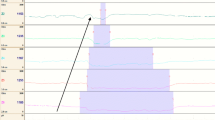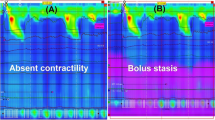Abstract
This paper describes multiple intraluminal impedance (MII) in 50 children with typical and atypical gastroesophageal reflux (GER) symptoms and discusses the possible clinical significance of objective numeric data provided by MII computed analysis. Patients underwent 24-hr pH/MII monitoring. Reflux parameters were analyzed with relation to age and reported symptoms. Nonacidic MII events occurred as frequently as acidic ones. A Pathologic Bolus Exposure Index associated with a normal pH Reflux Index was detected in 26% of our series. Significant correlations were found regarding acid and bolus clearing times and their ratio.
We conclude that the low rate of symptom occurrence in the pediatric population represents a limit on MII evaluation. Our study confirmed that nonacid GER is at least as frequent as acid GER. As MII provides interesting objective data that could be used in clinical practice, we suggest further research to define normal ranges in the pediatric population.
Similar content being viewed by others
References
Poets CF (2004) Gastroesophageal reflux: a critical review of its role in preterm infants. Pediatrics 113:128–132
Gold BD (2003) Outcomes of pediatric Gastroesophageal reflux disease: in the first year of life, in childhood, and in adults … oh, and should we really leave Helicobacter pylori alone? J Pediatr Gastroenterol Nutr 37:S33–S39
Kim J, Keininger DL, Becker S, Crawley JA (2005) Simultaneous development of the pediatric GERD Caregiver Impact Questionnaire (PGCIQ) in American English and American Spanish. Health Qual Life Outcomes 14;3(1):5
Mattioli G, Sacco O, Repetto P, Pini Prato A, Castagnetti M, Carlini C, Torre M, Leggio S, Gentilino V, Martino F, Fregonese B, Barabino A, Gandullia P, Rossi GA, Jasonni V (2004) Necessity for surgery in children with gastrooesophageal reflux and supraoesophageal symptoms. Eur J Pediatr Surg 14(1):7–13
Wenzl TG, Silny J, Schenke S, Peschgens T, Heimann G, Skopnik H (1999) Gastroesophageal reflux and respiratory phenomena in infants: status of the intraluminal impedance technique. J Pediatr Gastroenterol Nutr 28:423–428
Vandenplas Y, Belli D, Boige N (1992) A standardised protocol for the methodology of esophageal pH monitoring and interpretation of the data for the diagnosis of gastroesophageal reflux. Statement of the European Society of Pediatric Gastroenterology and Nutrition (ESPGAN). J Pediatr Gastroenterol Nutr 14:467–471
Rudolph CD, Mazur LJ, Liptak GS, Baker RD, Boyle JT, Colletti RB, Gerson WT, Werlin SL (2001) Guidelines for evaluation and treatment of gastroesophageal reflux in infants and children: recommendations of the North American Society of Pediatric Gastroenterology and Nutrition. J Pediatr Gastroenterol Nutr 32(Suppl 2):S1–S31
Mitchell DJ, McClure BG, Tubman TR (2001) Simultaneous monitoring of gastric and esophageal pH reveals limitations of conventional oesophageal pH monitoring in milk fed infants. Arch Dis Child 84:273–276
Fass R, Achem SR, Harding S, Mittal RK, Quigley E (2004) Review article: supraesophageal manifestations of gastroesophageal reflux disease and the role of night-time gastroesophageal reflux. Aliment Pharmacol Ther 20(S9):26–38
Wenzl TG (2002) Investigating esophageal reflux with the intraluminal impendance technique. J Pediatr Gastroenterol Nutr 43:261–268
Wenzl TG, Schenke S, Peschjens T, Silny J, Heimann G, Skopnik H (2001) Association of apnoea and non-acid gastroesophageal reflux in infants: investigations with the intraluminal impedance technique. Pediatr Pulmonol 31:144–149
Colletti RB, Christie DL, Orenstein SR (1995) Statement of the North American Society for Pediatric Gastroenterology and Nutrition (NASPGN). Indications for pediatric esophageal pH monitoring. J Pediatr Gastroenterol Nutr 21(3):253–262
Hegar B, Vandemaele K, Arana A, Vandenplas Y (2000) Esophageal pH monitoring in infants: elimination of gastric buffering does not modify reflux index. J Gastroenterol Hepatol 15(8):902–905
Wenzl TG (2003) Evaluation of gastroesophageal reflux events in children using multichannel intraluminal electrical impedance. Am J Med 115(3A):161S–165S
Silny J (1991) Intraluminal multiple electric impedance procedure for measurement of gastrointestinal motility. J Gastrointest Motil 3:151–162
Shay S, Tutuian R, Sifrim D, Vela M, Wise J, Balaji N, Zhang X, Adhami T, Murray J, Peters J, Castell D (2004) Twenty-four hour ambulatory simultaneous impedance and pH monitoring: a multicenter report of normal values from sixty healthy volunteers. Am J Gastroenterol 99(6):1037–1043
Johnson LF, De Meester TR (1974) Twenty-four-hour pH monitoring of the distal esophagus. A quantitative measure of gastroesophageal reflux. Am J Gastroenterol 62:325–332
Bagucka B, Badriul H, Vandemaele K, Troch E, Vandenplas Y (2000) Normal ranges of continuous pH monitoring in the proximal esophagus. J Pediatr Gastroenterol Nutr 31(3):244–247
Tutian R, Castell D (2005) Multichannel intraluminal impedance: general principles and technical issues. Gastrointest Endosc Clin N Am 15(2):257–264
National Institute of Health (1987) Consensus Development Conference on infantile apnea and home monitoring. Sept 29 to Oct 1, 1986. Consensus statement. Pediatrics 79:292–299
Seigel DG, Podgor MJ, Remaley NA (1992) Acceptable value of kappa for comparison of two groups. Am J Epidemiol 135(5):571–578
Sacco O, Fregonese B, Silvestri M (2000) Bronchoalveolar lavage and esophageal pH monitoring data in children with “difficult to treat” respiratory symptoms. Pediatr Pulmonol. 4:313–319
Sifirm D, Dupont L, Blondeau K, Zhang X, Tack J, Janssens J (2005) Weakly acidic reflux in patients with chronic unexplained cough during 24 hours pressure, pH, and impedance monitoring. Gut 54:449–454
Author information
Authors and Affiliations
Corresponding author
Rights and permissions
About this article
Cite this article
Mattioli, G., Pini-Prato, A., Gentilino, V. et al. Esophageal Impedance/pH Monitoring in Pediatric Patients: Preliminary Experience with 50 Cases. Dig Dis Sci 51, 2341–2347 (2006). https://doi.org/10.1007/s10620-006-9374-z
Received:
Accepted:
Published:
Issue Date:
DOI: https://doi.org/10.1007/s10620-006-9374-z




